Succeeded by Hassanal Bolkiah Name Omar Saifuddien | Monarch Hassanal Bolkiah Role Sultan of Brunei Preceded by post created | |
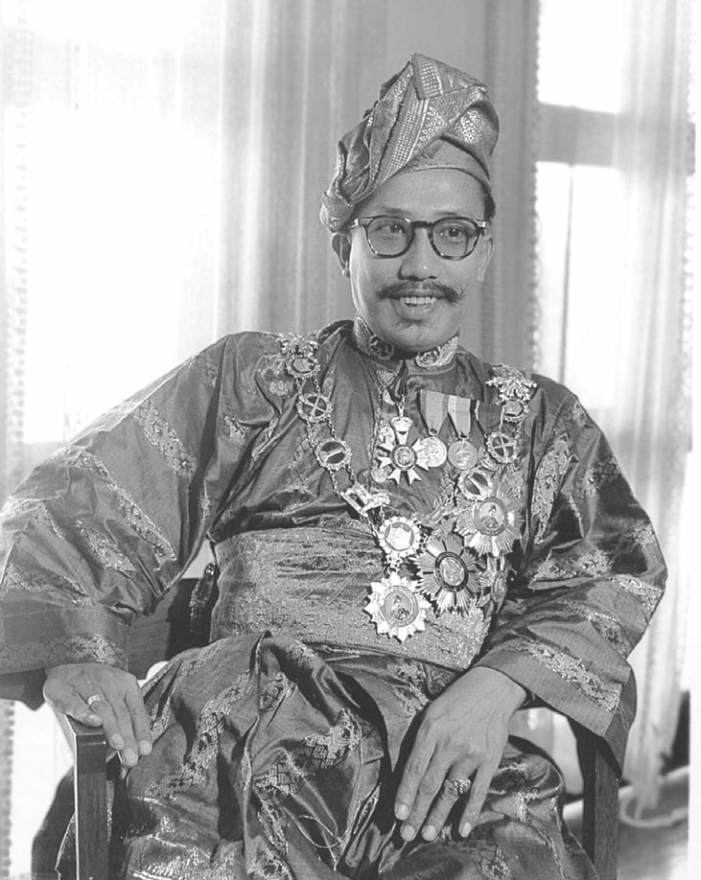 | ||
Full Name Pengiran Muda Tengah Omar 'Ali Saifuddien Spouse(s) Dayang Siti Amin binti Pehin Orang Kaya Pekerma Setia Diraja Awang Haji HashimPengiran Anak Damit (1941–1979 her death)Pengiran Bini Hajah Salhah(1979–1986) Children Hassanal Bolkiah, Pengiran Muda Mohamed Bolkiah, Jefri Bolkiah, Princess Masna Bolkiah Similar People Hassanal Bolkiah, Pengiran Anak Saleha, Pengiran Muda Mohame, Al‑Muhtadee Billah, Jefri Bolkiah | ||
Sultan omar ali saifuddien iii 1950 1967
Mullah Begawan Sultan Sir Muda Omar Ali Saifuddien III (full name, Sultan Haji Omar Ali Saifuddien Saadul Khairi Waddien ibni Sultan Muhammad Jamalul Alam II, GCVO, KCMG; 23 September 1914 – 7 September 1986) was the 28th Paramount Ruler and Sultan of Brunei who ruled from 4 June 1950 until his abdication from the throne on 4 October 1967. He was also the first Brunei Minister of Defence. He was known as The Architect of Modern Brunei, The Royal Poet, The Father of Independence, and The Father of Brunei's Negara Zikir.
Contents
- Sultan omar ali saifuddien iii 1950 1967
- Brunei Celebrates Malayan Film Unit documentary news reel 1958
- Early life
- Career Experiences
- Family
- Grandchildren
- Descendants
- Became Pengiran Bendahara
- Succession to the throne
- Contributions
- Developments in Religious Affairs and Religious Education
- Other contributions
- Notable visits by foreign leaders during reign
- Creation of the Constitution
- Writing of the Constitution
- Administration under the 1959 Constitution
- The National Development Plans
- The First National Development Plan
- The Second National Development Plan
- First State Election 1962
- Desire to join Malaysia
- Brunei Revolt
- Bruneis Stand on the issue of joining Malaysia
- Abdication
- Coronation of Hassanal Bolkiah
- Later life and Road to Independence
- Notable visits by foreign leaders to Brunei after abdication
- Post Independence
- Death and state funeral
- Relatives
- The Churchill Memorial in Brunei
- Personal Interest
- As a poet
- Legacies
- Further Historical dates
- Places named after Sultan Omar Ali Saifuddien III
- Appearance in currency
- Titles
- National Honours
- Foreign Honours
- Military Honours
- The Stars Insignia and Medals of Honour
- References
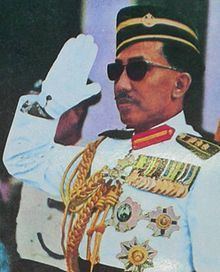
Brunei Celebrates - Malayan Film Unit documentary news reel, 1958
Early life
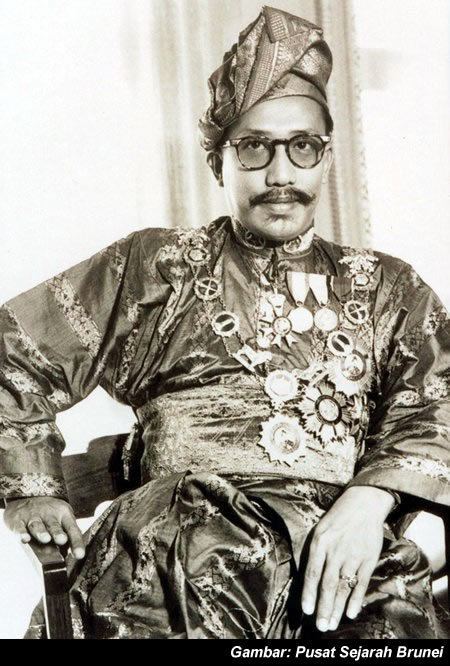
Pengiran Muda Omar Ali Saifuddien was born at Kota palace, Kampong Sultan Lama, Brunei Town on 3 Zulkaedah 1332 Hijrah, corresponding to 23 September 1914. He was the second of ten children of Sultan Muhammad Jamalul Alam II and Raja Isteri Fatimah. His older brother later become Sultan Ahmad Tajuddin. His siblings were; Pengiran Muda Besar, Pengiran Muda Tengah, Pengiran Anak Puteri Besar, Sultan Ahmad Tajuddin Akhazul Khairi Waddien, Pengiran Anak Puteri Tengah, Pengiran Anak Puteri Damit, Pengiran Muda Anum, Pengiran Muda Laila Gambar and Pengiran Muda Bongsu.
Career Experiences
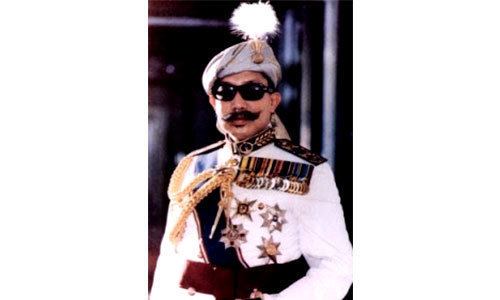
Pengiran Muda Omar Ali Saifuddien studied at the Malay College Kuala Kangsar in Perak, British Malaya from 1932 to 1936. After finishing education in Malaya, he returned to Brunei in 1936 to work in the Forestry Department, Kuala Belait as a cadet Officer. This job enabled him to be closer to the people in villages and remote areas. As such he was also able to understand the people's problems and their needs.
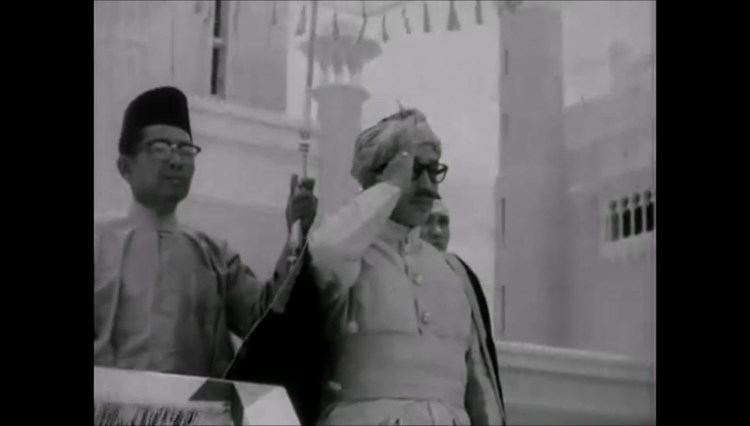
In 1938, he was transferred to the Judiciary Department, also in Kuala Belait in 1937. Here, he was able to learn about the Criminal and Civil Procedure Code from the Assistant British Resident, Hughes-Hallet. He remained there until 1938.
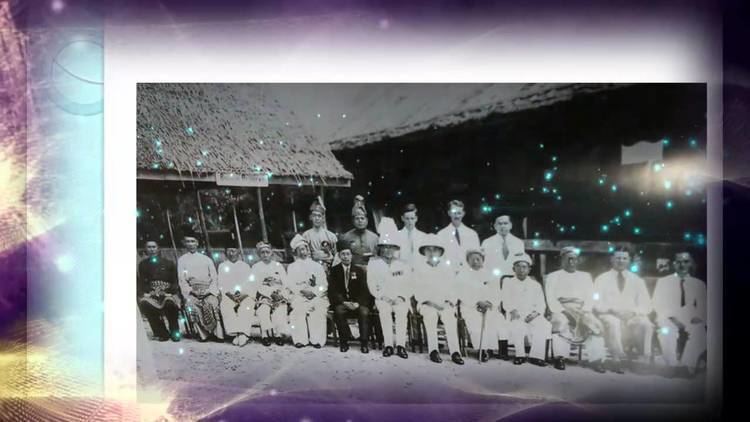
In 1941, he worked as an administrator in the British Resident's office. It was here that he studied English language under the guidance of H.F. Stalley.
During the period of Japanese Occupation and the Second World War, He worked at the Japanese Governor's office as a secretary to the Japanese Sub-district commander, Kimura.
After the war, in 1947, He was subsequently appointed a member of Brunei State Council and chairman of the Syariah Court.
He was the first member of the royal family to suggest fact-finding visits to the rural villages.
Family
His first wife was Dayang Siti Amin binti Pehin Orang Kaya Pekerma Setia Laila Diraja Awang Haji Hashim, but the couple had no children. On 6 September 1941, He married his cousin as his second wife, Pengiran Anak Damit binti Pengiran Bendahara Seri Maharaja Permaisuara Pengiran Anak Abdul Rahman. She was the granddaughter of Sultan Hashim Jalilul Alam Aqamaddin. She bore him 10 children, including the eldest, Hassanal Bolkiah, the incumbent Sultan of Brunei.
On 13 September 1979, his wife, Paduka Suri Seri Begawan Raja Isteri Pengiran Anak Damit died. After that, for the last time, he married Pengiran Bini Hajah Salhah binti Pengiran Bendahara Seri Maharaja Permaisuara Pengiran Anak Abdul Rahman, who was also his sister-in-law. The couple, however, had no children. She died on Friday, 18 February 2011.
Grandchildren
Sultan Omar Ali Saifuddien III had several grandchildren,
Descendants
Great Grandchildren
Became Pengiran Bendahara
He had the title Pengiran Bendahara Seri Maharaja Permaisuara conferred on him by his brother, Sultan Ahmad Tajuddin on 15 July 1947.
Succession to the throne
Upon the death of his brother, who left no male heirs, on 4 June 1950, he was proclaimed the next Sultan on 6 June 1950.
Omar Ali Saiffudien III was crowned as the Sultan Dan Yang Di-Pertuan of Brunei Darussalam on 31 May 1951. In conjunction of the coronation, he was conferred with the Honorary Companion of the Most Distinguished Order of Saint Michael and Saint George (CMG) by Queen Elizabeth II. In September 1951, upon becoming Sultan, he performed his first pilgrimage to Mecca, and made another in April 1962.
Contributions
Under Sultan Omar Ali Saifuddien III’s leadership, Brunei gradually gained self-rule while its external affairs and defence remained under the charge of Britain. The introduction of the 1959 constitution effectively brought to an end to the Resident’s rule in Brunei and reinstated the Sultan’s internal sovereignty, making him the supreme executive head of government in Brunei. He was increasingly able to make his own decisions in finance and administration.
In 1959, the post of the British Resident was replaced with that of High Commissioner. The High Commissioner was still required to give advice to the Sultan on all matters concerning the administration of the state except on matters pertaining to religion and customs.
One of his contributions was in raising the inherited monarchy to a height of prosperity. After he came to power, he faced formidable challenges from within the sultanate as well as from the British Government to bring Brunei in line with the status enjoyed by other Southeast Asian countries.
Developments in Religious Affairs and Religious Education
Upon his ascension to the throne, Sultan Omar Ali Saiffudien III also became the head of the Islamic religion in the country. His influence over religion guaranteed the continued beliefs and practices of Islam among the people.
One important contribution of the Sultan was to regularise Islamic administration in Brunei. In 1948, a religious council, comprising the Mohammedan Religious Advisers, was formed. Due to the Sultan's initiative, the council met for the first time on 31 January 1948. He himself was appointed chairman of this council. After examining several laws on Islamic affairs in the Malay Peninsula, the board made new proposals regarding the religious administration in Brunei.
According to his speech during the Opening Ceremony of the Shariah Council,
Sultan Omar Ali Saifuddien III was also responsible for the formation of the Department of Religious Affairs on 1 July 1954. The department was responsible for all the important decisions made on Islam in Brunei. All aspects of Islamic activities such as community life, laws, education, missionary activities and social administration were supervised by these two religious bodies.
Sultan Omar Ali Saifuddien III was also concerned about the insufficient time allocated for religious instruction in government schools, and authorized the government to request for assistance from Johor. In 1954, two religious officers from Johor were sent to Brunei. They were Haji Othman bin Mohammad Said and Haji Ismail bin Omar Abdul Aziz. (The latter, also known as Pehin Dato Seri Maharaja, was appointed as the State Mufti in 1962 until his death in 1993). As a result of their recommendations, in September 1956, religious schools operating in the afternoon were established.
The Bruneian government also offered religious scholarships to students with potential to continue their higher education overseas. This was limited to Aljunied Arabic School in Singapore at first, but from 1956 onwards, students were also sent to the Islamic College in Klang and Al-Azhar University in Cairo for degree courses.
Other contributions
Sultan Omar Ali Saifuddien III granted permission to build mosques and surau throughout the country in his efforts to expand and strengthen the Islamic religion. The most significant of all his achievements was the completion of a new state mosque named after him, the Omar Ali Saifuddien Mosque on 26 September 1958. He was also responsible for making Islam the state religion of Brunei. This was stated in the 1959 Constitution Agreement. Islam’s position was therefore strengthened in Brunei.
Notable visits by foreign leaders during reign
Creation of the Constitution
In 1952 the Sultan worked for the implementation of the constitution as the foundation of governance and the achievement of independence from the United Kingdom. On 9 June 1953, he was conferred with the Knight Commander of the Most Distinguished Order of Saint Michael and Saint George (KCMG) by Queen Elizabeth II.
Writing of the Constitution
In July 1953, Sultan Omar Ali Saifuddien III formed a seven-member committee named Tujuh Serangkai to find out the citizens’ views regarding a written constitution for Brunei. In May 1954, a meeting attended by the Sultan, the Resident and the High Commissioner was held to discuss the findings of the committee. In March 1959 the Sultan led a delegation to London to discuss the proposed constitution. The British delegation was led by Alan Lennox-Boyd, 1st Viscount Boyd of Merton who was the Secretary of State for the Colonies. The British Government later accepted the draft constitution.
On 29 September 1959, the Constitution Agreement was signed in Bandar Seri Begawan. The agreement was signed by Sultan Omar Ali Saifuddien III and Sir Robert Scott, the Commissioner-General for Southeast Asia. Some of the points of the constitution were:
Five councils were also set up:
Administration under the 1959 Constitution
Under the Constitution, the Sultan remained the supreme executive authority in the state. Five councils were created to assist him. They were the Executive Council, Privy Council, State Religious Council, Legislative Council and the Council of Succession. Five principal administrative posts were also created. They were the Menteri Besar (Chief Minister), State Secretary, Attorney-General, State Financial Officer and Religious Adviser.
During his reign, 3 chief ministers was appointed according to the Constitution. They were Pehin Dato Perdana Menteri Dato Laila Utama Haji Ibrahim Bin Mohammed Jahfar, Dato Paduka Haji Marsal Bin Maun, and Yang Amat Mulia Pengiran Setia Negara Pengiran Dr. Haji Mohd. Yusof bin Pengiran Haji Abdul Rahim.
The National Development Plans
A series of National Development Plans were initiated by the 28th Sultan of Brunei, Omar Ali Saifuddien III.
The First National Development Plan
The First National Development plan was introduced in 1953. A total sum of B$100 million was approved by the Brunei State Council for the plan. E.R. Bevington from the Colonial Office in Fiji. A $14 million Gas Plant was built under the plan. In 1954, survey and exploration work were undertaken by the Brunei Shell Petroleum on both offshore and onshore fields. By 1956, production reached 114,700 bpd. His Highness had launched the first delivery of 10-inch oil pipeline from the seabed off the coast of the Seria oil Base on 28 October 1964.
Developments on education were also made. In 1952, a written policy on education was made. By 1958, expenditure on education totalled at $4 million. Communications were also improved with new roads built and reconstruction works at Berakas Airport being completed at 1954.
The Second National Development Plan
The second National Development Plan was launched in 1962. A major oil and gas field was discovered in 1963, with this discovery, Liquefied Natural Gas became important. Developments in the oil and gas sector has continued actively and oil production has steadily increased since then. The plan also saw an increase of production of meat and eggs. The fishing industry increased its output by 25% throughout the course of the plan. The Muara Deepwater Port was also constructed under the plan. Power requirements were met and studies were made to provide electricity to rural areas. Efforts were made to eradicate malaria, with the help of the World Health Organisation, under the plan. Efforts were successful, bringing the down the cases of malaria from 300 cases in 1953 to only 66 cases in 1959. The death rate was also brought down from 20 per thousand in 1947 to 11.3 per thousand in 1953. This has been attributed to public sanitation and improvement of drainage and the provision of piped pure water to the population.
First State Election 1962
Brunei's first state election was held in 1962. This was to elect members to sit in the Brunei Legislative Councils. These elected members would then be involved in discussions of governmental policies. However, beside this, the Sultan still held the absolute power and authority in the government.
Among the political parties which contested in the election were Brunei People's Party (PRB), The Barisan Nasional Organisation (BNO), and The Brunei United Party (BUP).
The polling went on for two days on 30 and 31 August 1962. The Brunei People's Party won the election.
Desire to join Malaysia
When Tunku Abdul Rahman, the Prime Minister of the Federation of Malaya announced his proposal for a merger of Singapore, North Borneo, Sarawak, and Brunei, Sultan Omar Ali Saifuddien saw this as an opportunity for Brunei to achieve independence from British influence. He sent a congratulatory telegraph to Tunku Abdul Rahman, showing his support for the merger.
For him, Brunei as a small country, still needed a protection of a larger country; the only way to achieve this was by merging with Malaya and the rest of the states.
Brunei Revolt
On 8 December 1962, the PRB, led by A.M. Azahari led a rebellion against the government because of Brunei's intention to join Malaysia. With British military aid, the rebellion was later crushed and PRB were defeated. In July 1963, a year after the revolt, Sultan Omar Ali Saifuddien III made the decision that Brunei was not to join Malaysia.
Brunei's Stand on the issue of joining Malaysia
After the rebellion, the discussion still goes on. Sultan Omar Ali Saifuddien III sent a delegation to attend meetings of the Malaysia Solidarity Consultative Committee (MSCC). The views of the people was also seek by the committee chaired by Marsal Bin Maun, the Chief Minister of Brunei at that time.
The views were varied, some were in favour of Brunei joining Malaysia, some opposed and some wanted the Sultan to make the decision.
In 1963, a meeting was held to discuss the prospect of Brunei joining Malaysia. They failed to reach an agreement on the issues of Brunei's oil revenue and federal rights to taxation. The Sultan also refused to accept that he was to ranked as the most junior member in line to be the Yang Di Pertuan Agong of Malaysia. In fact, the then-Yang Di Pertuan Agong of Malaysia at that time was waiting to finish his term.
Finally, the Federation of Malaysia was formed on 16 September 1963, without Brunei.
Abdication
After ruling for 17 years, on 4 October 1967, Sultan Omar Ali Saifuddien willingly abdicated in favour of his eldest son, Crown Prince Hassanal Bolkiah. At the time of the announcement, the Crown Prince was in England, training as a cadet at the Royal Military Academy, Sandhurst. The Prince returned immediately to Brunei.
After his abdication from the throne at the age of 53, he took the title of His Royal Highness Paduka Seri Begawan Sultan, a title he held until his death in 1986. He was conferred with the Honorary Grand Commander of the Victorian Order (GCVO) by Her Majesty Queen Elizabeth II during her visit to Brunei on 29 February 1972.
Coronation of Hassanal Bolkiah
After his abdication, his eldest son, Crown Prince Hassanal Bolkiah ascended the throne to become the twenty ninth Sultan of Brunei.
The coronation ceremony began with the flying of the yellow flag at Bukit Panggal and the red flag at Bukit Sungai Kebun in February 1968. The announcement was also made throughout the country by Radio Televisyen Brunei. The new Sultan rode to his coronation at the Lapau Diraja on 1 August 1968, on a royal carriage drawn by fifty specially selected soldiers of the Royal Brunei Armed Forces.
Omar Ali Saifuddien placed the crown on the head of his son, and handed him the Keris Si Naga, symbol of supreme power in Brunei.
The new Sultan took vows to maintain peace and prosperity of the nation. He also promised to improve the standard of living of his subjects through various development projects and the protect and uphold Islam and Brunei's Adat Istiadat.
After the crowning ceremony, the new Sultan proceeded in procession through the capital, passing lines of school children cheering 'Daulat Tuanku.'
Among the foreign dignitaries who attended the ceremony were, the Prime Minister of Singapore, Lee Kuan Yew, the Malaysian Prime Minister, Tunku Abdul Rahman, and the British High Commissioner to Brunei, A.R. Adair, who represented Queen Elizabeth II.
Later life and Road to Independence
Although he had retired from the throne and all his responsibilities to his country had been handed over to his son, Hassanal Bolkiah, but as a father, he still held the lead responsibility towards his son’s perfection. That is why he always held open discussion together with his son, both in Council or anywhere, including in London. He wanted to see his son’s success in leading the administration of the State. He always led and guided his son in carrying out the duties as the Sultan of Brunei in preparation for the time Brunei would eventually become an independent and sovereign country.
Notable visits by foreign leaders to Brunei after abdication
Post-Independence
Brunei achieved its independence on 1 January 1984. Although he had abdicated seventeen years ago, Omar Ali Saifuddien III continued to play an important role as a mentor to his son. He was elected as the first Minister of Defence and consequently conferred the rank of Field Marshal in the Royal Brunei Armed Forces. He attended the first Celebration of Independence Day of Brunei Darussalam on 23 February 1984.
Omar Ali Saifuddien III welcomed the arrival of Yasser Arafat, the Chairman of Palestine Liberation Organisation (PLO) on his official visit to Brunei on 26 July 1984.
As Defence Minister, he attended the official opening ceremony of the Reconnaissance Armoured Vehicle Squadron of the Royal Brunei Armed Forces on 30 July 1984. He also attended the opening ceremony of the International Literary Festival IV on 9 December 1985.
Death and state funeral
Omar Ali Saifuddien III died on 7 September 1986, several weeks before he would have his 72nd birthday. On that day, the Grand Chamberlain, officially announced his death.
On 8 September, a state funeral was held. A large number of world leaders attended the funeral, including Malaysian Yang Di-Pertuan Agong, Iskandar of Johor and fellow Malay Rulers from Malaysia such as Sultan Ahmad Shah of Pahang, the Yang Di Pertuan Besar of Negeri Sembilan, Tuanku Jaafar, Sultan Mahmud Al-Muktafi Billah Shah of Terengganu, Tuanku Syed Putra of Perlis, Sultan Abdul Halim of Kedah, Sultan Salahuddin of Selangor and Sultan Azlan Shah of Perak, US Vice President George H. W. Bush (representing President Ronald Reagan), President of the Philippines Corazon Aquino, Queen Elizabeth II and the Duke of Edinburgh, President Suharto of Indonesia, President Muhammad Zia-ul-Haq of Pakistan, President Hussain Muhammad Ershad of Bangladesh, Secretary of British Foreign Affairs and the Commonwealth, Sir Geoffrey Howe, and many others.
His body was laid in state at the "Lapau" (the former Legislative Building at Bandar Seri Begawan) before being moved to nearby Sultan Omar Ali Saifuddin Mosque for a funeral prayer. A casket draped with his royal standard flag was placed on a hand drawn carriage for the funeral procession around the Capital. He was buried in the Royal Mausoleum in Bandar Seri Begawan, alongside his wife, and his father, Sultan Muhammad Jamalul Alam II, his grandfather, Sultan Hashim Jalilul Alam Aqamaddin and his eldest brother and predecessor Sultan Ahmad Tajuddin.
Several foreign leaders had given their quotes about Sultan Omar Ali Saifuddien III,
A Surah Yassin book was published with the consent of Sultan Hassanal Bolkiah, to mark the 40th day of the passing away of his late father.
Relatives
Sultan Omar Ali Saifuddien III was the second cousin of Pehin Orang Kaya-Kaya Koroh bin Santulan of Keningau in Sabah, Malaysia, the First Native Paramount Leader of (North Borneo), now Sabah state, Malaysia who was also the father of former Sabah State Minister Tan Sri Stephen (Suffian) Koroh, and Sabah's fifth State Governor, Tun Thomas (Ahmad) Koroh, (the elder brother of Suffian). Santulan, the father to Pehin Orang Kaya-Kaya Koroh was an ethnic mixed race Kadazan-Dusun and Murut descendant of Hashim Jalilul Alam Aqamaddin, the 25th Sultan of Brunei, was also a Pengeran (by descent).
The Churchill Memorial in Brunei
He was a keen admirer of the wartime British Prime Minister, Sir Winston Churchill. This can be seen in the way he dressed in several occasion.
He also ordered the construction of Churchill Memorial at Bandar Seri Begawan. Now, the memorial had become the Royal Brunei Regalia Building.
Personal Interest
He had an interest in writing poems. Apart from that, he was also known for designing the national medals. He also made a design of flowers on his cloths, the "Tenunan Brunei" which he wore on several occasions.
Also, he was interested in self-defence martial arts such as silat and kuntau.
As a poet
His works is on "Syair" (poet). Among his poems were:-
This poems contains his advices for the people of Brunei.
Legacies
Further Historical dates
Places named after Sultan Omar Ali Saifuddien III
Appearance in currency
His portrait is depicted on the obverse. The reverse of these coins, and all subsequent series, was designed by Christopher Ironside OBE. The coins issued were 1, 5, 10, 20, and 50 sen.
His portrait also depicted in Brunei's $500 note. On the $25 note depicting the picture of him crowning his son as his successor to Sultan.
